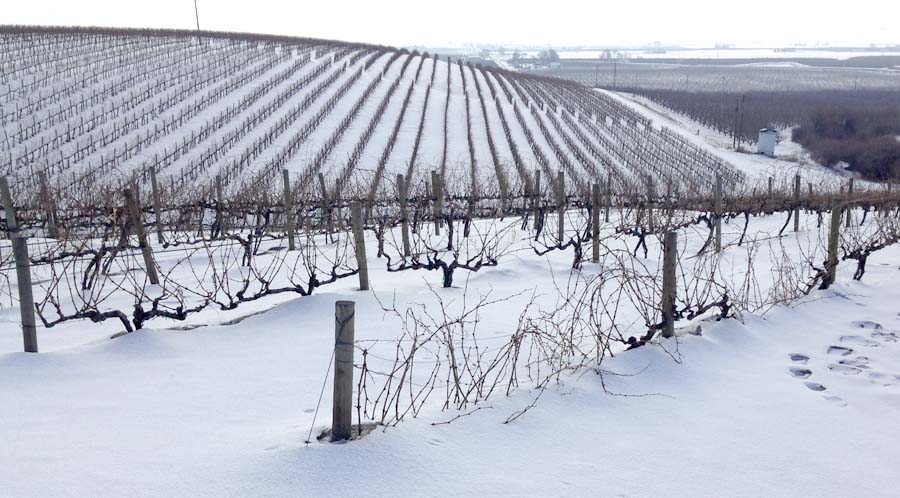
Some of Côte Bonneville’s vines in their Yakima valley vineyard is covered by recent snow on January 21, 2017. (Courtesy Kerry Shiels/Côte Bonneville)
It’s been a very wintery winter in the Northwest. While temperatures have not dipped below grapevine’s cold hardiness limits for the most part, one Washington State University researcher is still concerned the lengthy cold-snap in January could cause cumulative damage to buds.
That’s why growers should check some buds for damage before pruning back their vineyards, WSU Viticulture Professor Markus Keller warned growers at the Washington Wine Commission’s research review earlier this week.
“With cold damage, we need to distinguish between acute stress and chronic stress. Buds get killed immediately when it gets really cold, but with chronic stress, we have these prolonged low temperatures that are never low enough to kill the bud outright, but eventually, it could be damaged from dehydration,” Keller told Good Fruit Grower. “It’s usually only a problem in a winter like this.”
January 2017 was the coldest month on record for AgWeatherNet’s Prosser station, meteorologist Nic Loyd said, citing records that date back to 1989. January averaged about 13 degrees below normal in Pasco and 8 degrees below normal in Yakima, according to the National Weather Service.
“January was particularly cold due to two cold outbreaks in first part of the month, including the first one later in the first week of January, and the second one around mid-month. Although the latter part of the month was generally more seasonal, it was certainly not warm enough to balance out the early cold,” Loyd said in an email.
Keller cautioned that there is no research that proves that chronic cold stress can damage grape buds, so he’s offering his warning to growers based on anecdotal evidence and his own understanding of how below-freezing temperatures affect the vines physiologically. He’s applied for grants to study the phenomenon before without success.
“So we think we’re on to something but we have no proof,” Keller said. “As a scientist, I don’t like to talk about something without the data to back it up … but it’s something growers might want to consider before pruning.”
His theory is that buds can become dehydrated during prolonged, but not acute cold, because the water between plant cells freezes well before the water inside the cells does. Over time, that frozen exterior then pulls water out of the cells, dehydrating them perhaps to the point of damage, Keller said.
He’s seen it in his lab. The tests used to measure cold hardiness – slowly cooling vines to see what temperature is required to freeze and burst bud cells – also measures when that extracellular water freezes, too. That happens in the range of between 23 and 14 degrees, while damage to the cells isn’t usually recorded until about minus 4 degrees or below.
Freezing that extracellular water doesn’t directly cause damage, so it’s not posted with the real-time cold hardiness monitoring WSU publishes for growers, Keller said. But over time it could lead to damaging bud dehydration.
“The dehydration damage, if this is correct, would depend on how long the bud has been exposed to low temperature, so it’s a matter of time and temperature,” he said. Eventually, he’d like to see a formula developed, similar to the degree day index for warm, growing conditions, that assesses cumulative cold stress.
But without data to build such a tool, Keller just wants to warn growers to be on the lookout for cold-damaged buds. He plans to talk about the damage he’s seen at WSU’s vineyards with growers at the Washington Association of Wine Grape Growers’ annual meeting in Kennewick next week.
“We are finding damage on a few varieties; the majority seem fine so far,” Keller said. “The warning to the growers is don’t assume everything is fine. Go and cut and check some buds before you make any pruning decisions.”
Good Fruit Grower will also be covering the wine grape growers’ annual meeting next week, so check back with us for news updates online and on Facebook and Twitter.






Leave A Comment